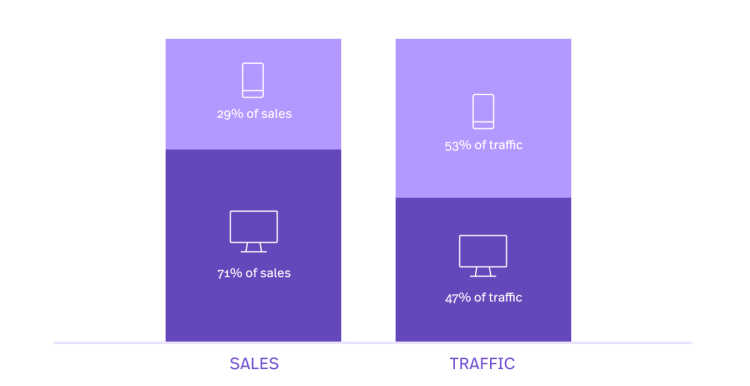In 2007, the first iPhone hit the market. It ran on 2G wireless, was only available through AT&T, had no App Store, and couldn’t send (its comparatively poor quality) photos via text message. Still, it was the cutting edge of mobile, and sold over 12 million devices in its first two years.
Today, with Siri, Portrait Mode, iCloud, and face recognition at our fingertips, the first-generation iPhone seems almost primitive.
While mobile devices have come a long way in the last decade and a half, many mobile experiences are still lagging behind—and in many cases, causing lost revenue.
In 2020, across all industries, mobile visits accounted for 53% of website traffic, but only 29% of sales. Conversely, desktop users made up 47% of website traffic, and 71% of sales.
Why the gap? Poor mobile experiences.
This disconnect in mobile experience means there’s an opportunity for organizations to pull ahead of the pack by proactively investing in improving their mobile experiences through digital experience intelligence.
Mobile experiences can be tricky to analyze and optimize, though, which is why it’s critical to choose the right digital experience intelligence (DXI) platform.
What makes mobile experiences so difficult to optimize?
Analyzing and optimizing any digital experience is a complex process, but mobile experiences can be exceptionally opaque. Why? Mobile experiences don’t have the same uniformity that desktop experiences do because there’s no single common mobile technology.
Mobile experiences can involve unique codebases, myriad operating systems, independent development teams handling iOS and Android apps, and many other factors that make monitoring them complicated. Simple recording technologies, which capture a video or images from a mobile session, simply aren’t flexible enough to provide meaningful DX data.
When done correctly, digital experience intelligence can help navigate these obstacles to provide trustworthy mobile experience insights.
But how do you know when DXI is “done correctly?” Here are three tells.
A dynamic combination of quantitative and qualitative data
Improving your mobile experience (and therefore creating competitive advantage) requires a deep understanding of both what is happening in your mobile experience and why it’s happening.
Digital experience intelligence takes the quantitative data developers want (where users click, what they type, where they scroll, and how they navigate their app) and blends it with qualitative features (like session replay and frustration heuristics) that reveal user emotion and intent.
Only this combination of data can provide a deep, honest view into the mobile experience.
A privacy-first approach
The data we just described is invaluable for perfecting mobile experiences—but only if it’s collected and analyzed with the highest level of regard for user privacy.
Tools that simply record everything a mobile user sees on their screen are not only flawed by the lack of flexibility mentioned above, but because they also elevate the risk of collecting sensitive user data.
Leading DXI platforms circumvent this risk by using a privacy-first capture model in which elements of the app that are marked for exclusion are entirely excluded from capture, rather than being redacted after the fact.
A balance between performance and bandwidth
From a performance standpoint, many screen recording tools fall on two opposite ends of the spectrum: they record in native screen resolutions (resulting in gigantic file sizes), or they downscale the recording (resulting in choppy, low-res playback).
With the right DXI solution, mobile teams no longer have to determine which is the lesser of two evils. Leading digital experience platforms have the capability to balance optimized file sizes with high fidelity replay.
And because DXI captures this data at an app’s structural level (rather than by recording the screen), high-fidelity replay doesn’t come at the cost of sucking up bandwidth.
FullStory's Digital Experience Intelligence won the 2022 Gold Stevie Award for Mobile Digital Experience. Learn more.
More and more, mobile devices are the next frontier for winning and retaining customers by providing an exceptional digital experience. As the leader in digital experience intelligence, FullStory takes a highly advanced approach to capturing and analyzing your mobile DX data, proactively surfacing areas for improvement while maintaining user privacy and optimizing for performance.
For more details on the technology behind DXI for mobile and how it can revolutionize your app experience, download our guide.
Meet other DX pros and share best practices at Spark, the first Digital Experience Intelligence conference. Register here.







